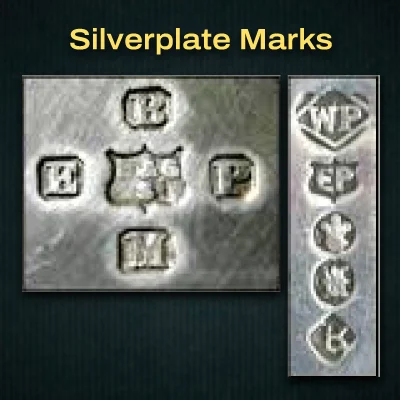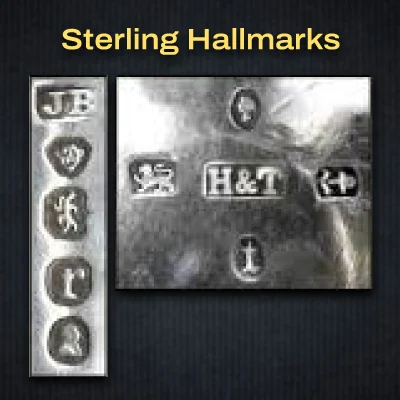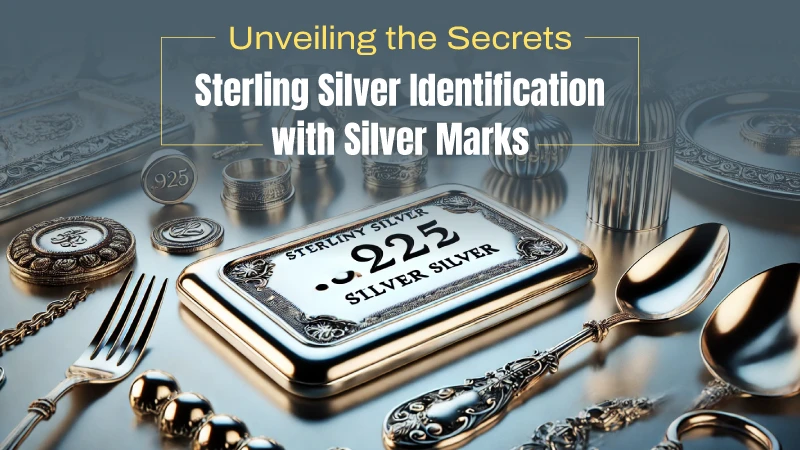Silver is the most common mineral among those classified as precious
metals, yet its younger brother, sterling silver, is quite popular due to
its charm. Its authentication doesn’t have to be a mystery. Sterling
silver identification silver marks are what every enthusiast will
appreciate for their future purchase or maintaining existing ones.
Sterling silver has been used for a very long time to create jewelry,
bullion, serving pieces, decorative things, and a variety of other goods.
Most silver objects contain a mark indicating the purity of the silver
used.
For instance, items made with the purest forms of silver are marked .999.
However, silver is too soft to be used in manufacturing if it is alloyed
with other metals. For this reason, the majority of silver—including
sterling silver—fits into the alloy category. A piece of metal must
contain 92.5% pure silver to be considered sterling silver.
post for sterling silver identification silver marks.
Understanding Silver Purity
The amount of pure silver in an alloy is referred to as silver purity, and
it is typically stated as a percentage or parts per thousand. A coin
containing 99.5% silver and 0.5% another metal, like copper, is called a
.995 purity
silver coin.
Here are some common types of silver purity:
-
Sterling Silver: the industry standard for silver jewelry and
ornamentation, is 92.5% pure silver. The 925 stamp is frequently used to
identify sterling silver. - Britannia: often known as 958 silver, is 95.8% pure silver.
-
Fine Silver: It is the purest type of silver, containing 99.9%
pure silver. A 999 stamp is frequently used to identify fine silver.
Common Silver Alloys and Their Markings

The following lists some of the most popular varieties of silver alloys
along with information on typical markings for them:
-
Brittania Silver (950): An alloy called Brittania silver has a
silver content of 95%, which is higher than that of sterling silver. The
most common marking is 950. -
Sterling Silver (925): This is the benchmark for silver,
designating an item as strong as possible if it contains at least 92.5%
silver combined with copper. These items have the marks Sterling or 925
on them. A mark like 950, which denotes a larger percentage of silver,
would also be considered sterling. -
Coin Silver (900): It is not possible to refer to this alloy as
sterling because it contains just 90% silver. This alloy can be used to
make items with marks like Coin, Standard, and 900. -
European Silver (800): This is another non-sterling variety of
silver alloy that is sometimes referred to as continental silver. Marks
that represent 80, 82.5, 83, or 85% silver content, respectively, are
800, 825, 830, or 850.

Silverplate: Silver-plated items have very little silver in
them. A silver plate marking, which is occasionally combined with a
manufacturer’s mark, signifies that a base metal was electroplated
with a relatively thin layer of silver to create the object. Items
with the Quadruple Plate mark have had four layers of silver put over
the base metal. These are of a higher caliber and are less likely to
tarnish to the bare metal when polished. Silverplate tarnishes like
real silver, thus periodic cleaning is necessary to maintain its
luster.
Common Sterling Silver Hallmarks

Silver is such a delicate metal that it is rarely ever employed by
manufacturers by itself. With 7.5% other metals like copper and
nickel, sterling silver is made up of 92.5% pure silver.
- “Sterling” “Sterling silver” “925” “925/1000” “92.5% pure”
-
English sterling silver with a lion passant, or a lion with one paw
lifted. - The Thistle mark designates Scottish-made sterling.
- Irish-made silver harp with a crown
Steps for Sterling Silver Identification with
Silver Marks
Silver Marks
-
Search for a Mark or a Stamp: These are always small, so they can
easily be located on the underside, edge, or handle of each item. -
Search for 925 Mark: The most frequent mark signifying sterling
silver is “925,” which is punched to indicate its authenticity. It
stands for 92.5% pure silver. Once you see “925” being punched, it means
you have a sterling silvered -
Hallmarks: Most silver items will be hallmarked. These are tiny
symbols or letters that reveal the locality, year, and maker of a piece.
These frequently differ by country, although common marks consist of the
lion, crown, and anchor symbols. -
Search for Sterling Marke: Some items might have the term
“Sterling” imprinted on them, indicating that the item is genuinely made
of sterling silver.
Analyzing the Clarity of the Mark
-
Determine Mark’s Clarity: Real silver marks tend to be sharp and
clear. Dim or fuzzy marks may mean the item you are testing is just
silver-plated, not solid silver. -
Look Up Unknown Marks: When you encounter an unknown mark, you
can look it up online or in a silver hallmark reference book. This way,
you will be able to establish unequivocally whether the item is sterling
silver or not. -
Test the Silver if in Doubt: If in doubt after checking the
hallmarks, a simple test can always be done with a magnet or a kit
designed for silver testing.
Conclusion
In conclusion, sterling silver identification with silver marks and
other types of silver is a valuable skill that can help you determine
the authenticity and value of silver items. By understanding the common
markings, such as “925” for sterling silver, and recognizing hallmarks,
you can easily verify the purity of silver. Whether you’re a collector,
jeweler, or just someone who enjoys silver pieces, knowing how to read
these marks ensures you’re getting genuine silver and not a
silver-plated imitation. Remember to check for clarity in the markings,
and when in doubt, don’t hesitate to test the silver.


